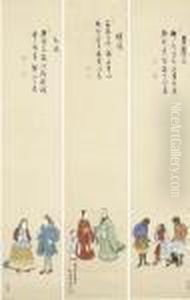Sakaki Hyakusen Paintings
Sakaki Hyakusen was a Japanese painter and the founder of the Nanga (Southern Painting) school of Japanese painting in the Edo period. He was born in 1697 in present-day Niigata Prefecture, though some sources suggest he may have been born in Kyoto. Hyakusen's early life is not well-documented, but he is believed to have learned the art of painting by studying Chinese Song and Yuan dynasty literati painting, which he adapted to Japanese tastes, laying the groundwork for the Nanga movement.
Hyakusen's style was characterized by a blend of Chinese literati ideals with Japanese artistic traditions. His paintings often featured landscapes, flowers, and birds, with an emphasis on expressive brushwork and a preference for monochromatic ink washes, though he occasionally used color. He was known for his ability to capture the spirit of nature with a few deft strokes, a technique that reflected the Zen Buddhist philosophy of simplicity and directness.
The Nanga school, which Hyakusen is credited with founding, became an important artistic movement in 18th-century Japan. It was made up of literati painters who sought to express their personal intellectual and artistic pursuits, and who often shared a scholarly background. This school of painting was a counterpoint to the more formal, academic styles that were sponsored by the shogunate and the imperial court.
Hyakusen's influence extended to his students and followers, such as Yosa Buson and Ike no Taiga, who further developed the Nanga style. His legacy is seen in the way he incorporated scholarly ideals into his art and helped to transmit the literati painting tradition of China to Japan, thus creating a unique genre of Japanese painting.
He died in 1752, leaving behind a body of work that continued to inspire Japanese artists for generations. Today, Sakaki Hyakusen is remembered as a pivotal figure in the history of Japanese art, and his paintings are valued for their historical significance as well as their artistic beauty.

